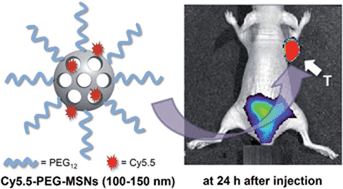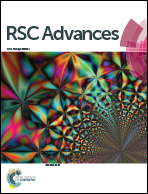Enhanced tumor targetability of PEGylated mesoporous silica nanoparticles on in vivo optical imaging according to their size†
Abstract
This paper reports the results of a particle size-dependent in vivo optical imaging study using mesoporous silica nanoparticles (MSNs) in a mouse xenografted U87MG (Human glioblastoma-astrocytoma) tumor model. Near-infrared (NIR) fluorescent dye (Cy5.5)-functionalized PEGylated MSNs (Cy5.5-PEG-MSNs) with three different particle sizes (≈30 nm, 100–150 nm and >300 nm) were fabricated. Among the three different particles sizes of the MSNs, the 100–150 nm-sized Cy5.5-PEG-MSNs provided the strongest fluorescence intensity in the tumor 24 h after injection with a low background signal from the normal tissues. In contrast, the ≈30 nm-sized Cy5.5-PEG-MSNs were washed out rapidly. The necropsy revealed the 100–150 nm-sized Cy5.5-PEG-MSNs to have approximately 4–6.5 fold higher uptake at the tumor site than the MSNs with other different sizes (≈30 or >300 nm in sizes). On the other hand, the larger (>300 nm)-sized MSNs were taken up mainly in the spleen and liver via the reticuloendothelial system (RES). Consequently, the 100–150 nm range is the optimal particle size for MSNs to maximize passive tumor targeting due to the enhanced permeability and retention (EPR) effect.


 Please wait while we load your content...
Please wait while we load your content...